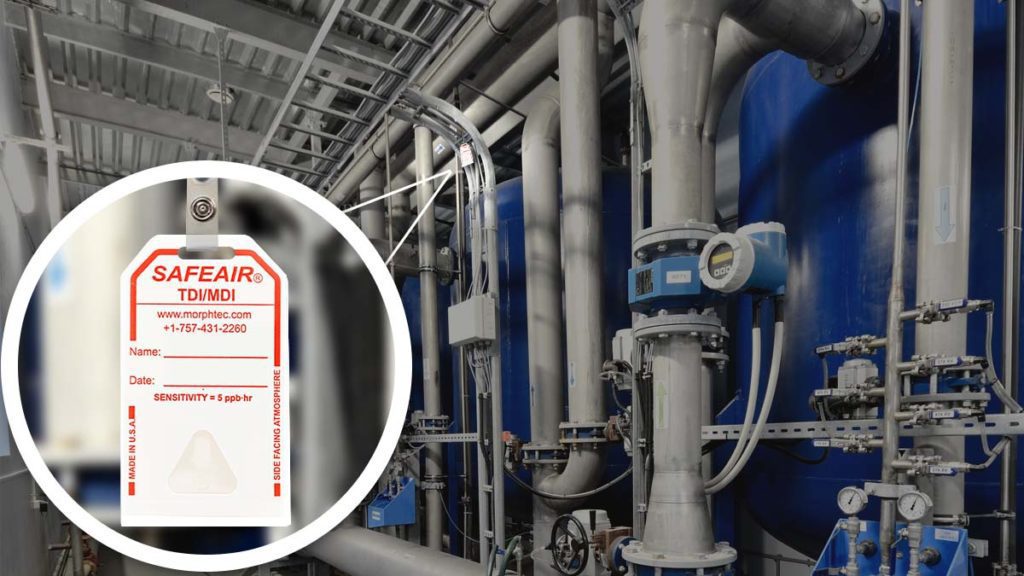
Complete your EHS strategy with SafeAir badges, designed to make chemical hazard detection in foam production effortless and reliable. Explore more about TDI and MDI monitoring in foam production below.
The Regulatory Landscape: Navigating TDI/MDI Compliance in Foam Production
In the foam production industry, regulatory compliance is a critical aspect that ensures worker safety and environmental protection. Toluene Diisocyanate (TDI) and Methylene Diphenyl Diisocyanate (MDI) are commonly used chemicals in the manufacture of polyurethane foams for products like mattresses, car seats, and furniture. Both TDI and MDI are regulated under OSHA’s Hazard Communication Standard and the EPA’s Toxic Substances Control Act (TSCA). Compliance involves monitoring worker exposure to these chemicals to ensure it remains below permissible exposure limits.
Keeping up with these regulations can be challenging due to the complexity of foam manufacturing processes and the stringent monitoring requirements. Traditional methods often require extensive equipment, frequent calibration, and laboratory analysis, making them both time-consuming and expensive. This is where SafeAir badges can make a real difference.
Traditional Monitoring Methods: Challenges and Limitations
Traditional chemical monitoring methods in foam production often involve the use of complex equipment like electronic gas detectors and sampling pumps. These methods require regular maintenance, calibration, and often, laboratory analysis to interpret the results. This not only incurs significant costs but also requires specialized training for employees to operate the equipment effectively.
Another limitation is the time it takes to get results. In many cases, samples need to be sent to a lab, leading to delays in identifying and mitigating chemical hazards. This lag can compromise worker safety and the overall efficiency of the production process. Additionally, these methods can be cumbersome to implement on a large scale, making it difficult for EHS managers to maintain continuous and comprehensive monitoring.
Revolutionizing EHS with SafeAir Badges: Features and Benefits
SafeAir badges offer a simple yet revolutionary approach to chemical hazard detection that addresses the limitations of other methods. These badges are easy to use, highly sensitive, and selective, providing an immediate visual indication when a specific chemical hazard is present. The sensor in the SafeAir badge is constructed from a coated indicator layer, ensuring a homogeneous and stable color change, which forms an exclamation mark in the badges’ viewing window when a hazard is detected.
One of the standout features of SafeAir badges is that they require no calibration or laboratory analysis. This simplicity makes them ideal for daily employee screening or leak detection, significantly reducing costs and administrative burdens. The badges can measure Time-Weighted Average (TWA) exposure, offering a reliable and cost-effective solution for continuous monitoring. Furthermore, their minimal training requirement means that workers can easily integrate them into their daily routines.
Integrating SafeAir Badges into Large-Scale Foam Production Operations
Integrating SafeAir badges into large-scale foam production operations is straightforward and highly beneficial. These badges can be distributed among employees to wear during their shifts, ensuring that exposure to TDI and MDI is continuously monitored and offering effective TDI and MDI monitoring in foam production. The immediate visual indication provided by the badges allows for quick responses to any detected hazards, enhancing both worker safety and operational efficiency.
For large-scale operations, the scalability of SafeAir badges is a significant advantage. They can be used across various sections of the production floor without the need for extensive setup or calibration. This makes them an excellent tool for EHS managers looking to maintain compliance with minimal disruption to workflows. Additionally, the badges can be used in conjunction with other monitoring systems to provide a comprehensive safety strategy.
More information on SafeAir TDI/MDI Badges
Morphix SafeAir TDI/MDI badges detect the presence of aromatic isocyanates at a threshold level of 5ppb·hr. These badges may be used in conjunction with the optional color comparator (sold separately) to further quantify the exposure dose from 5-140ppb·hr.
The SafeAir TDI/MDI badge is available for purchase through the Morphix Amazon Storefront for our U.S. customers.
For customers outside the US, email or call to be referred to a distributor.